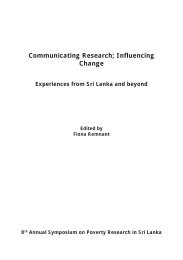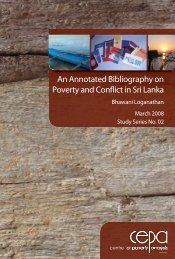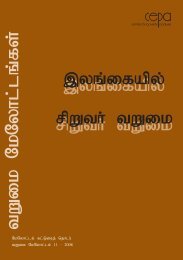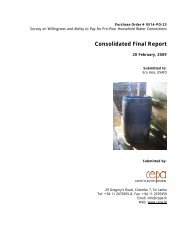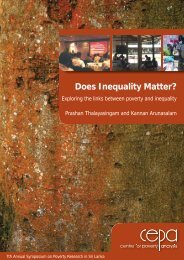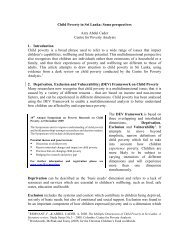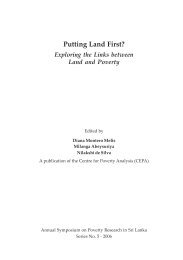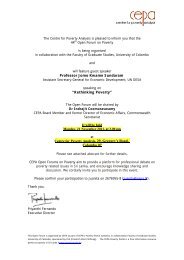Involuntary Displacement and Resettlement â Policy and ... - CEPA
Involuntary Displacement and Resettlement â Policy and ... - CEPA
Involuntary Displacement and Resettlement â Policy and ... - CEPA
- No tags were found...
Create successful ePaper yourself
Turn your PDF publications into a flip-book with our unique Google optimized e-Paper software.
of the household did find paid work (three days a month on average), butthis was not agriculture related. This demarcates Type II Labour from TypeI. The former, unlike the latter, is unable to generate livelihoods afterdisplacement. The primary reason for this can be traced to dem<strong>and</strong> − thereis no dem<strong>and</strong> for Type II Labour in the township of Batticaloa. There are nopaddy fields in its vicinity <strong>and</strong> so no dem<strong>and</strong> for agricultural labour. Inaddition, obtaining work in paddy fields involves networking, which is notavailable to the IDPs. Lack of income from their main livelihood in the IDPsetting had meant that Household 9 is below the poverty line. It must beappreciated that this level of poverty has struck the household in spite ofhaving a comparatively large amount of cash at the time of displacement(Rs.60,000). Were it not for that they would have been impoverished evenmore. This household, after displacement, earned only 25% of itspre-displacement income.The third case study in Table 1 is on Household 66, whose main income wasfrom the Government Servant father. He was, before displacement, a trainedagriculture teacher attached to Sampur Maha Vidyalayam. He also ownedfive acres of paddy l<strong>and</strong>, one acre of dry l<strong>and</strong>, <strong>and</strong> a poultry farm. Incomefrom these ancillary sources was lower than that from the main livelihood,teaching. <strong>Displacement</strong> made him lose his entire ancillary asset basedincome. However, he continues to be a government teacher even afterbeing displaced. This has been possible because of a mechanism called‘attachment’, which is described below.After their establishment in 1987, Provincial Councils were given the powerto appoint <strong>and</strong> transfer teachers within provincial schools. Under specialpersonal circumstances, a teacher appointed to a provincial school canrequest attachment to a school in a different location, for a short period. Ifthe request is granted, the teacher will report <strong>and</strong> work at the attachedschool. However, his/her salary will have to be collected from the originalschool. This mechanism has, by now, evolved as an effective strategy tocope with CID. For example, in the village of Sampur there were two schools,both of which have now ceased to function 12 . The teachers <strong>and</strong> students ofthese schools are displaced <strong>and</strong> many of them are in Batticaloa 13 .12In the twenty-six villages that were displaced there were nineteen schools.13Schools in Batticaloa have accommodated the displaced teachers <strong>and</strong> students from Sampur.When schools cannot accommodate the students because of lack of capacity they have optedto have evening school. Students, teachers, <strong>and</strong> even the principals of such evening schools areall IDPs.70



